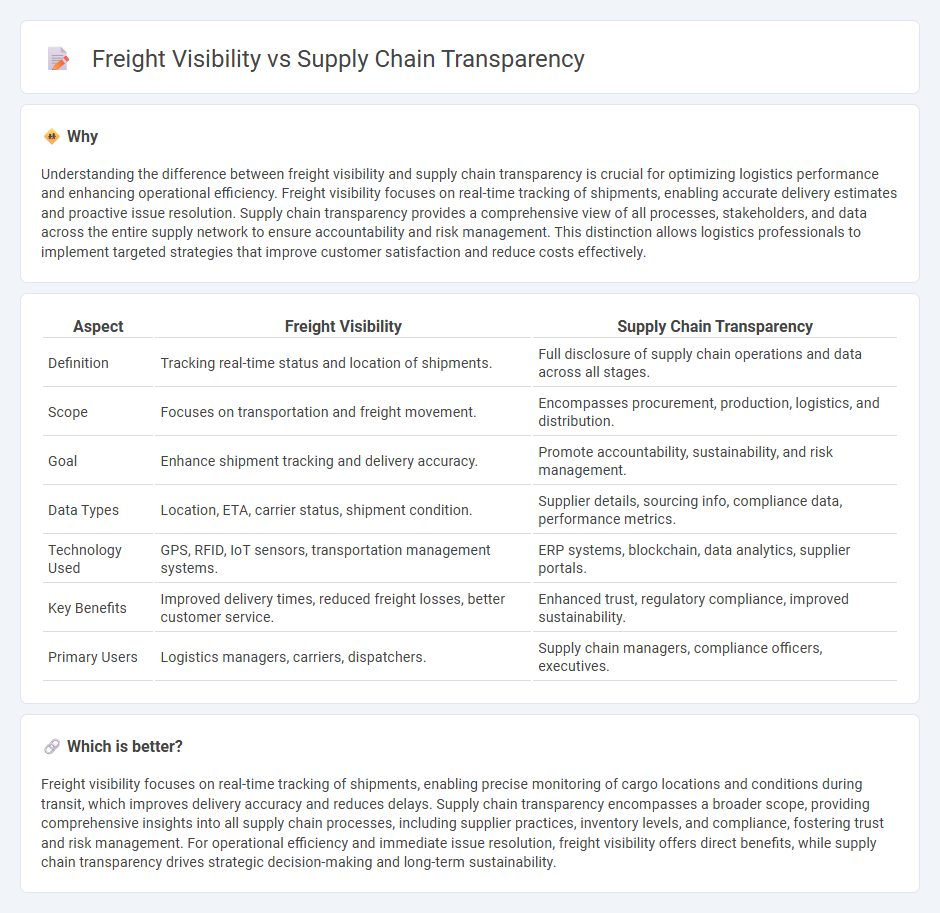
Freight visibility focuses on real-time tracking and monitoring of shipments throughout the transportation process, enhancing operational efficiency and delivery accuracy. Supply chain transparency encompasses a broader view, providing end-to-end insights into procurement, production, and distribution activities to ensure accountability and sustainability. Explore how integrating freight visibility with supply chain transparency drives smarter logistics strategies.
Why it is important
Understanding the difference between freight visibility and supply chain transparency is crucial for optimizing logistics performance and enhancing operational efficiency. Freight visibility focuses on real-time tracking of shipments, enabling accurate delivery estimates and proactive issue resolution. Supply chain transparency provides a comprehensive view of all processes, stakeholders, and data across the entire supply network to ensure accountability and risk management. This distinction allows logistics professionals to implement targeted strategies that improve customer satisfaction and reduce costs effectively.
Comparison Table
| Aspect | Freight Visibility | Supply Chain Transparency |
|---|---|---|
| Definition | Tracking real-time status and location of shipments. | Full disclosure of supply chain operations and data across all stages. |
| Scope | Focuses on transportation and freight movement. | Encompasses procurement, production, logistics, and distribution. |
| Goal | Enhance shipment tracking and delivery accuracy. | Promote accountability, sustainability, and risk management. |
| Data Types | Location, ETA, carrier status, shipment condition. | Supplier details, sourcing info, compliance data, performance metrics. |
| Technology Used | GPS, RFID, IoT sensors, transportation management systems. | ERP systems, blockchain, data analytics, supplier portals. |
| Key Benefits | Improved delivery times, reduced freight losses, better customer service. | Enhanced trust, regulatory compliance, improved sustainability. |
| Primary Users | Logistics managers, carriers, dispatchers. | Supply chain managers, compliance officers, executives. |
Which is better?
Freight visibility focuses on real-time tracking of shipments, enabling precise monitoring of cargo locations and conditions during transit, which improves delivery accuracy and reduces delays. Supply chain transparency encompasses a broader scope, providing comprehensive insights into all supply chain processes, including supplier practices, inventory levels, and compliance, fostering trust and risk management. For operational efficiency and immediate issue resolution, freight visibility offers direct benefits, while supply chain transparency drives strategic decision-making and long-term sustainability.
Connection
Freight visibility enhances supply chain transparency by providing real-time tracking and status updates of shipments, enabling companies to monitor the movement of goods at every stage. This connection allows for proactive issue resolution, improved demand forecasting, and better coordination among stakeholders. Enhanced transparency through freight visibility reduces delays, optimizes inventory management, and strengthens overall supply chain resilience.
Key Terms
Supply Chain Transparency:
Supply chain transparency involves end-to-end tracking of materials, production processes, and supplier practices to ensure ethical sourcing and compliance with regulations. It enables companies to identify risks, improve sustainability, and build trust with consumers by providing detailed insights into every stage of the supply network. Explore how enhanced supply chain transparency can drive operational efficiency and promote corporate responsibility.
Traceability
Supply chain transparency ensures comprehensive traceability by providing end-to-end visibility of product origins, manufacturing processes, and distribution channels, which enhances compliance and risk management. Freight visibility specifically tracks the real-time location and condition of shipments, improving operational efficiency and customer satisfaction. Explore how integrating traceability with freight visibility can optimize logistics and supply chain management.
Compliance
Supply chain transparency involves comprehensive monitoring of all processes to ensure regulatory compliance and ethical standards throughout the entire supply chain. Freight visibility specifically tracks shipments in real-time to meet compliance requirements related to transportation, customs, and safety regulations. Explore how enhancing freight visibility can strengthen overall supply chain transparency and compliance.
Source and External Links
Supply Chain Transparency Defined: Why It Matters and Its ... - Supply chain transparency is the practice of openly sharing information about practices, policies, and outcomes within the entire supply chain to ensure ethical standards and build consumer trust, distinct from supply chain visibility which focuses more on internal operational tracking.
What Is Supply Chain Transparency? - Supply chain transparency involves providing access to information about how and where products are made, including labor practices and environmental impacts, to both companies and external stakeholders like consumers, enabling responsible decision-making aligned with sustainability and social responsibility goals.
Supply chain transparency: creating stakeholder value - Achieving supply chain transparency requires collecting and sharing detailed information across all supply chain tiers with internal and external stakeholders to improve decision-making, manage risks, and increase collaboration, thereby creating value for business leaders, partners, regulators, and consumers alike.
 dowidth.com
dowidth.com